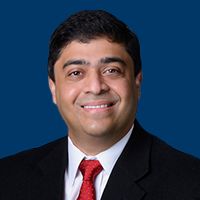News
Article
Lirafugratinib Elicits Durable Responses Across Several FGFR2+ Solid Tumors
Author(s):
Lirafugratinib demonstrated clinical activity in multiple subsets of patients with FGFR2-altered solid tumors, including those with FGFR2-altered hormone receptor–positive, HER2-negative breast cancer.
Don Bergstrom, MD, PhD

Lirafugratinib (RLY-4008) demonstrated clinical activity in multiple subsets of patients with FGFR2-altered solid tumors, including those with FGFR2-altered hormone receptor–positive, HER2-negative breast cancer, according to data from the phase 1/2 ReFocus trial (NCT04526106) presented at the 2023 AACR-NCI-EORTC International Conference on Molecular Targets and Cancer Therapeutics.1,2
Efficacy with the agent was observed across FGFR2 alterations. In those with fusions/rearrangements (n = 26), lirafugratinib elicited an objective response rate (ORR) of 35% (95% CI, 17%-56%) by RECIST v1.1 criteria with a disease control rate (DCR) of 69% (95% CI, 48%-86%). In those with amplifications (n = 34), these rates were 24% (95% CI, 11%-41%) and 62% (95% CI, 44%-78%), respectively; these rates were 13% (95% CI, 3%-32%) and 42% (95% CI, 22%-63%), respectively, in those with mutations (n = 24).
Responses achieved with the agent proved to be durable across solid tumors harboring FGFR2 alterations, with 58.8% of 17 patients experiencing a duration of response of at least 6 months.
In all tumor types (n = 60), lirafugratinib induced an ORR of 28% and a DCR of 65%. Responses were observed in 8 tumor types: gastric cancer (n = 22), breast cancer (n = 7), pancreatic cancer (n = 6), non–small cell lung cancer (NSCLC; n = 4), ovarian cancer (n = 4), colorectal cancer (CRC; n = 3), carcinoma of unknown primary (CUP; n = 3), and other (n = 11).2 The ORRs in these subgroups were 18%, 43%, 33%, 50%, 50%, 33%, 67%, and 9%, respectively; the DCRs were 64%, 71%, 67%, 75%, 75%, 67%, 100%, and 45%, respectively.
In heavily pretreated patients with hormone receptor–positive, HER2-negative breast cancer (n = 10), the ORR achieved with lirafugratinib was 40%; the DCR in this group was 70%. Notably, 70% of these patients also harbored ESR1 mutations. Forty percent of patients experienced partial responses. The DOR in this group ranged from 5.6+ months to 12.8+ months, with all patients experiencing a DOR that lasted for 6 months or longer.
“These data provide important early evidence that RLY-4008, or lirafugratinib, has the potential to help both patients with FGFR2-fusion cholangiocarcinoma as previously reported, as well as those with multiple other types of FGFR2-altered tumors,” Don Bergstrom, MD, PhD, president of R&D at Relay Therapeutics, stated in a press release.1 “We are excited by the potential for lirafugratinib to help many more patients and are focused on advancing this opportunity as well as our PI3Kα programs, with the initiation of a RLY-2608 triplet combination trial this year.”
Although oncogenic activation of FGFR2 drives several cancers, selective targeting of FGFR2 has not yet been achieved, Alison M. Schram, MD, a medical oncologist at Memorial Sloan Kettering, said in a presentation of the data.2 Pan-FGFR inhibitors are approved in only 2 solid tumor indications: pemigatinib (Pemazyre) and futibatinib (Lytgobi) for cholangiocarcinoma and erdafitinib (Balversa) for urothelial carcinoma. In contrast with these agents, lirafugratinib represents a potent and selective FGFR2 inhibitor, Schram noted, adding that the agent previously demonstrated strong in vivo activity spanning tumor types and FGFR2alterations.
ReFocus enrolled patients with histologically or cytologically confirmed unresectable or metastatic solid tumors that had a documented FGFR2 gene fusion, mutation, or amplification by local testing of the blood and/or tumor.3 To participate, they were required to have measurable disease by RECIST v1.1 criteria, an ECOG performance status of 0 or 1, and disease that was refractory or unresponsive to, or lacking a, standard treatment.
If patients had central nervous system (CNS) metastases or a primary CNS tumor linked with progressive neurologic symptoms, they were excluded, as were those with unacceptable organ function or clinically significant FGFR inhibitor–induced retinal detachment.
The primary end points of the study were ORR and safety. Key secondary end points comprised DOR, DCR, and pharmacokinetics.
The dose-escalation portion of the trial utilized a Bayesian Optimal Interval design where lirafugratinib was administered orally, once daily or twice daily.2 The recommended phase 2 dose (RP2D) was determined to be 70 mg once daily. The dose-expansion portion of the research included a pivotal cohort of patients with cholangiocarcinoma and a cohort of patients with advanced solid tumors, excluding cholangiocarcinoma, harboring FGFR2 alterations.
Data from the cholangiocarcinoma cohort revealed that lirafugratinib provided robust target coverage without FGFR1-related hyperphosphatemia. At the RP2D, there was a predicted median receptor occupancy of at least 96%. The effective half-life of approximately 18 hours to 26 hours supported daily dosing of the agent.
Additionally, initial efficacy of the agent in those with cholangiocarcinoma and FGFR2 fusions or rearrangements was noted to be robust, according to Schram. In FGFR inhibitor–naïve patients (n = 38), the confirmed ORR was 57.9% spanning all doses given. In FGFR inhibitor–naïve patients who received lirafugratinib at the RP2D (n = 17), the confirmed ORR was even higher, at 82.4%.
In the efficacy population of patients with solid tumors that were not cholangiocarcinoma (n = 84), the median age was 62 years (range, 33-84). More than half of patients were female (61%), White (55%), and had an ECOG performance status of 1 (62%). The number of prior lines of systemic therapy received was 2.5 (range, 0-11). Notably half of patients had received 3 or more prior lines of therapy. Regarding tumor type, most patients had gastric cancer (31%), followed by other (18%), breast cancer (17%), pancreatic cancer (8%), ovarian cancer (6%), CRC (5%), NSCLC (5%), endometrial cancer (5%), CUP (4%), and salivary gland cancer (2%).
Lirafugratinib was reported to have a manageable toxicity profile that minimized off-isoform effects. Treatment-related adverse effects (TRAEs) occurring in at least 15% of patients included nail toxicities (all grade, 48%, grade 3, 0%), stomatitis (47%; 11%), Palmar-plantar erythrodysesthesia (44%; 7%), dry mouth (31%; 0%), dry skin (22%; 0%), alopecia (20%; 0%), fatigue (19%; 1%), retinal pigment epithelium detachment (19%; 1%), dry eye (16%; 0%), dysgeusia (15%; 0%), and hyperphosphatemia (15%; 0%).
Moreover, 47.6% of patients required dose interruptions due to TRAEs, 35.5% needed dose reductions, and 0.8% of patients discontinued treatment. At the time of the data cutoff date of August 23, 2023, 30.6% of patients were still receiving treatment with the agent.
References
- Relay Therapeutics announces initial RLY-4008 (lirafugratinib) data demonstrating durable responses across multiple FGFR2-altered solid tumors. News release. Relay Therapeutics, Inc. October 12, 2023. Accessed October 13, 2023. https://ir.relaytx.com/news-releases/news-release-details/relay-therapeutics-announces-initial-rly-4008-lirafugratinib
- Schram AM, Subbiah V, Liao C-Y, et al. Clinical activity of lirafugratinib (RLY-4008), a highly selective FGFR2 inhibitor, in patients with advanced FGFR2-altered solid tumors: the ReFocus study. Presented at: 2023 AACR-NCI-EORTC International Conference on Molecular Targets and Cancer Therapeutics; October 11-15, 2023; Boston, MA. https://relaytx.com/wp-content/uploads/2023/10/Schram-ENA-2023-Lirafugratinib-Oral-Presentation.pdf








